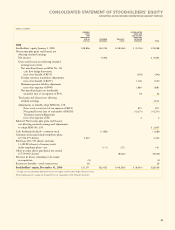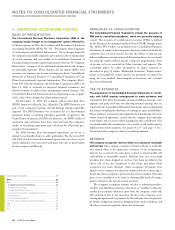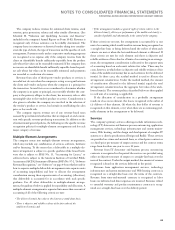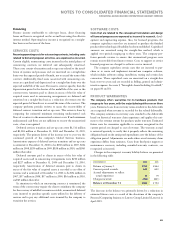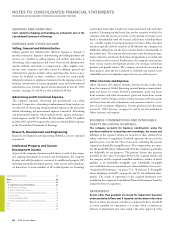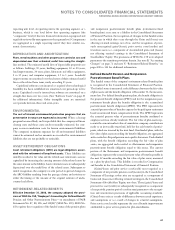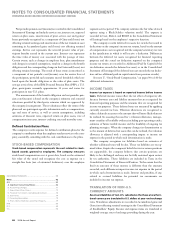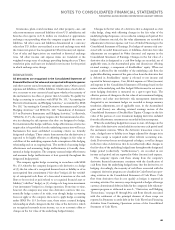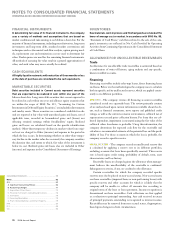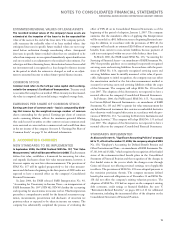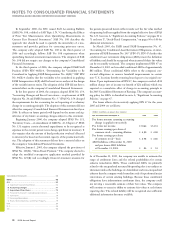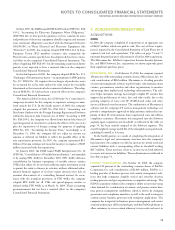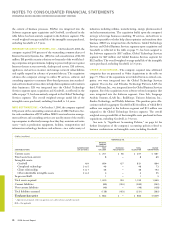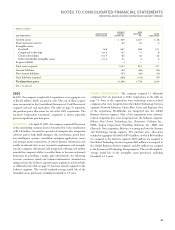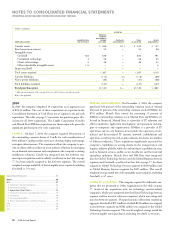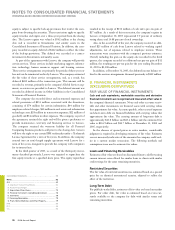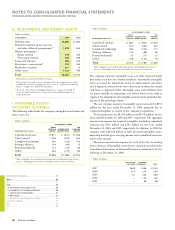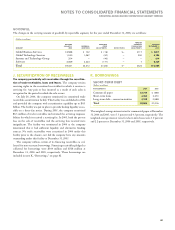IBM 2006 Annual Report Download - page 73
Download and view the complete annual report
Please find page 73 of the 2006 IBM annual report below. You can navigate through the pages in the report by either clicking on the pages listed below, or by using the keyword search tool below to find specific information within the annual report.Black
MAC
390 CG10
ESTIMATED RESIDUAL VALUES OF LEASE ASSETS
The recorded residual values of the company’s lease assets are
estimated at the inception of the lease to be the expected fair
value of the assets at the end of the lease term. The company periodi-
cally reassesses the realizable value of its lease residual values. Any
anticipated increases in specific future residual values are not recog-
nized before realization through remarketing efforts. Anticipated
decreases in specific future residual values that are considered to be
other-than-temporary are recognized immediately upon identification
and are recorded as an adjustment to the residual-value estimate. For
sales-type and direct financing leases, this reduction lowers the recorded
net investment and is recognized as a loss charged to finance income
in the period in which the estimate is changed, as well as an adjust-
ment to unearned income to reduce future-period finance income.
COMMON STOCK
Common stock refers to the $.20 par value capital stock as desig-
nated in the company’s Certificate of Incorporation. Treasury stock
is accounted for using the cost method. When treasury stock is reissued,
the value is computed and recorded using a weighted-average basis.
EARNINGS PER SHARE OF COMMON STOCK
Earnings per share of common stock—basic is computed by divid-
ing Net income by the weighted-average number of common
shares outstanding for the period. Earnings per share of common
stock—assuming dilution, reflects the maximum potential dilution
that could occur if securities or other contracts to issue common stock
were exercised or converted into common stock and would then share
in the net income of the company. See note S, “Earnings Per Share of
Common Stock,” on page 95 for additional information.
B. ACCOUNTING CHANGES
NEW STANDARDS TO BE IMPLEMENTED
In September 2006, the FASB finalized SFAS No. 157, “Fair Value
Measurements,” which will become effective in 2008. This Statement
defines fair value, establishes a framework for measuring fair value,
and expands disclosures about fair value measurements; however, it
does not require any new fair value measurements. The provisions of
SFAS No. 157 will be applied prospectively to fair value measure-
ments and disclosures beginning in the first quarter of 2008 and is not
expected to have a material effect on the company’s Consolidated
Financial Statements.
In June 2006, the FASB released FASB Interpretation No. 48,
“Accounting for Uncertainty in Income Taxes—an interpretation of
FASB Statement No. 109” ( FIN 48). FIN 48 clarifies the accounting
and reporting for uncertainties in income tax law. This Interpretation
prescribes a comprehensive model for the financial statement recog-
nition, measurement, presentation and disclosure of uncertain tax
positions taken or expected to be taken in income tax returns. The
company has substantially completed the process of evaluating the
effect of FIN 48 on its Consolidated Financial Statements as of the
beginning of the period of adoption, January 1, 2007. The company
estimates that the cumulative effects of applying this Interpretation
will be recorded as a $0.1 billion increase to beginning Retained earn-
ings. In addition, in accordance with the provisions of FIN 48, the
company will reclassify an estimated $2.0 billion of unrecognized tax
benefits from current to non-current liabilities because payment of
cash is not anticipated within one year of the balance sheet date.
In March 2006, the FASB issued SFAS No. 156, “Accounting for
Servicing of Financial Assets—an amendment of FASB Statement No.
140,” that provides guidance on accounting for separately recognized
servicing assets and servicing liabilities. In accordance with the provi-
sions of SFAS No. 156, separately recognized servicing assets and
servicing liabilities must be initially measured at fair value, if practi-
cable. Subsequent to initial recognition, the company may use either
the amortization method or the fair-value measurement method to
account for servicing assets and servicing liabilities within the scope
of this Statement. The company will adopt SFAS No. 156 in fiscal
year 2007. The adoption of this Statement is not expected to have a
material effect on the company’s Consolidated Financial Statements.
In February 2006, the FASB issued SFAS No. 155, “Accounting
for Certain Hybrid Financial Instruments—an amendment of FASB
Statements No. 133 and 140,” to permit fair value remeasurement for
any hybrid financial instrument that contains an embedded derivative
that otherwise would require bifurcation in accordance with the pro-
visions of SFAS No. 133, “Accounting for Derivative Instruments and
Hedging Activities.” The company will adopt SFAS No. 155 in fiscal
year 2007. The adoption of this Statement is not expected to have a
material effect on the company’s Consolidated Financial Statements.
STANDARDS IMPLEMENTED
As discussed in note A, “Significant Accounting Policies,” on pages
62 to 71, effective December 31, 2006, the company adopted SFAS
No. 158, “Employer’s Accounting for Defined Benefit Pension and
Other Postretirement Plans—an amendment of FASB Statements No.
87, 88, 106 and 132(R),” which requires the recognition of the funded
status of the retirement-related benefit plans in the Consolidated
Statement of Financial Position and the recognition of the changes in
that funded status in the year in which the changes occur through
Gains and ( losses) not affecting retained earnings, net of applicable
tax effects. The provisions of SFAS No. 158 were adopted pursuant to
the transition provisions therein. The company measures defined
benefit plan assets and obligations as of December 31 and SFAS No.
158 did not affect the company’s existing valuation practices. The
adoption of SFAS No. 158 had no impact on the company’s existing
debt covenants, credit ratings or financial flexibility. See note V,
“Retirement-Related Benefits,” on pages 100 to 111 for additional
information, including the incremental effect of the adoption on the
Consolidated Statement of Financial Position.
NOTES TO CONSOLIDATED FINANCIAL STATEMENTS
INTERNATIONAL BUSINESS MACHINES CORPORATION AND SUBSIDIARY COMPANIES
71


